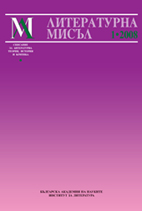Байроновият „Манфред” на български език
Manfred in Bulgarian context
Author(s): Vitana KostadinovaSubject(s): Literary Texts
Published by: Институт за литература - БАН
Keywords: Byron’s Manfred; Reception; Context of Bulgarian Modernism
Summary/Abstract: The paper considers Byron’s Manfred in the context of Bulgarian Modernism and the popularity of the poem, which underwent nine translations and fourteen editions within the first half of the 20th century. It considers Jauss’ discussion of a “second horizontal change” (1982) and Iser’s reflections on the relationship between text structure and reception processes (1972-1976). For all its popularity, a number of the poem’s messages got lost in translation. The essay focuses on three major versions of Manfred in Bulgarian and considers some points of departure from the original. Tracing how the three translations differ on account of the translators' aesthetic commitments (individualism, expressionism and symbolism would be the key words here), the texts are analyzed in terms of what they tell us about chronotopes, about Bulgarian culture in particular and cultural translation in general. In the process of analyzing the variability of translated texts, Stanley Fish’s question “Is there a text in this class?” emerges modified. In addition, there are always the cultural and literary allusions of the original text to be considered. The essay provides illustrations of the loss of some religious connotations in the Bulgarian translations examined. In conclusion, Susan Bassnett’s interpretation of the “violet in the crucible” metaphor is discussed. Translation is seen as a dynamic development from the initial realization of the author’s intention, through the numerous cultural transformations of the original text to a specific concretization, rather than a static result of language conversion.
Journal: Литературна мисъл
- Issue Year: 2008
- Issue No: 1
- Page Range: 161-185
- Page Count: 24
- Language: Bulgarian
- Content File-PDF

